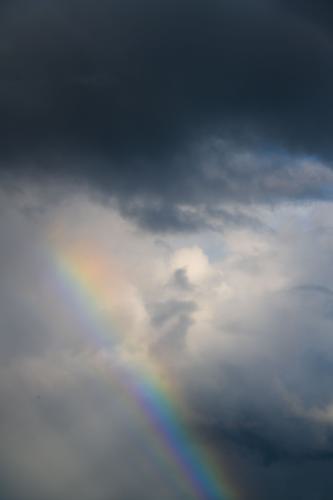

DEFINITION
Katharine Hayhoe
Climate Scientist
Climate change involves more than just global warming, the long-term rise in the average temperature of the planet. For many of us, its impacts are most evident in the increasingly unpredictable and “weirder” weather patterns we’re experiencing.
Global weirding speaks to the complex ways climate change is affecting weather globally. It refers to the fact that many extreme weather events are becoming more frequent and/or more severe than they were in the past.
As the planet warms, we’re seeing more record-breaking heatwaves. Wildfire seasons are longer, and fires are burning greater areas. Hurricanes and other tropical storms are intensifying faster, becoming stronger, and dumping more rain. Heavy downpours and flash flooding are more frequent, and droughts are more severe.
Every part of the globe is witnessing these changes. The United States, for example, experienced an average of one billion-dollar weather or climate disaster every four months in the 1980s. By the 2010s, however, a disaster was occurring every three weeks, on average.
“Global weirding” affects us all, but it doesn’t affect us all equally. Communities that are already marginalised, lacking access to clean water, sufficient food, or reliable housing, are often most vulnerable to these disasters. They are impacted more strongly, and take longer to recover. “Global weirding” sounds the alarm, underscoring the urgent need for climate action to ensure a safe and liveable future for all.

Scotland's Summer of 2023, characterized by unpredictable weather during Storm Betty, showcased the impact of the cyclical El Niño effect and climate change, offering a glimpse into future climatic shifts with the fifth warmest and wetter-than-average summer on record. Hebrides Sea, Scotland, 2023.
Photography By Pamela EA
RESEARCH
Coined by Hunter Lovins, a founder of the Rocky Mountain Institute, Global Weirding conceptualizes the abnormal and often disastrous consequences of a warming planet. Natural disasters are amplified by an increase in average global temperature, such as more violent storms and intense flooding. The term “Global Warming” has caused further skepticism from climate change deniers because of recent examples of strange and extremely cold weather events. In January 2024, U.S. powerhouse snowstorms in the Northeast killed at least 4 people in 2 weeks and created widespread power outages. While Global Warming describes the rise in global average temperature, Global Weirding can be used to avoid confusion around the human-made consequences of a warming planet, such as climate extremes like record snowfall, intense hurricanes, and droughts.
The relationship between global warming and climate change is often misunderstood. Meteorologist Scott Duncan explains, “If you’ve got a graph showing that temperature is changing over a long period of time, you can say that’s climate change.” However, zooming in the graph will show varying weather patterns that are increasingly adverse and unusual—a result of soaring global temperatures. While the earth has gone through many natural climate cycles in the past from changes in the periodicity and angle of the earth’s orbit, the current warming our planet is experiencing is due to an extreme increase of carbon dioxide (CO2) concentration in the atmosphere, mainly due to the extractive fossil fuel industry. More CO2 means more heat trapped in the atmosphere, leading to more energy in the system. This growing amount of energy is intensifying our weather events, creating an imbalance in our climate system. The anthropogenic impact on our planet is not natural and is unprecedented in our climate history, creating unpredictable weather patterns that impact all life on earth.
Specifically, the increase of energy can be used to evaporate more water (leading to more droughts in one area) and since warmer air holds more water, it creates more flooding in another. Globally, there is 4% more water vapor in the atmosphere compared to 1970. The water cycle is intensifying and as our global temperature rises, so too will the frequency and intensity of droughts and floods. Since the beginning of the last century, earth has warmed by 1°C and each of the last 5 decades has been successively warmer than the one before. Future trends in the U.S. predict that by 2100, the Northeast will experience more rain and the Southwest will have stronger droughts. Global Weirding best captures the abnormality of these extreme weather trends, beyond the rise in global average temperature.
The Intergovernmental Panel on Climate Change (IPCC) first recognized Global Weirding in its Fourth Assessment Report on Climate Change in 2007. “Advances since the [Third Assessment Report] show that discernible human influences extend beyond average temperatures to other aspects of climate”, revising its previous report from 2001. Global Weirding illustrates the strange and unexpected weather events that are increasingly prevalent in a world exploited by Big Oil. Addressing these extreme consequences requires mitigating the root cause of this environmental shift and implementing sustainable practices to prevent intense weather events from enacting further ecological and human harm.
Waldman, John. “With Temperatures Rising, Here Comes ‘Global Weirding.” Yale E360, 2009. https://e360.yale.edu/features/with_temperatures_rising_here_comes_global_weirding
Falconer, Rebecca. "In photos: Massive winter storm blasts U.S." Axios, 2024. https://www.axios.com/2024/01/10/storm-photos-snow-rain-winds-tornadoes
Zeh, Julia. 2016. “Global Weirding: The Basics of Ocean Acidification and Climate Change.” NAMEPA. October 25, 2016. https://namepa.net/2016/10/25/2016-10-25-global-weirding-part-1/
Clarke-Ezzidio, Harry. 2021. “Why We Need to Talk about ‘Global Weirding.’” New Statesman.https://www.newstatesman.com/science-tech/2021/04/why-we-need-talk-about-global-weirding
Anderson, Rebecca. “ACE Report: Why Global Warming Means Global Weirding.” n.d. Our Climate Our Future. https://ourclimateourfuture.org/activity/ace-report-why-global-warming-means-global-weirding/
Anderson, Rebecca. “ACE Report: Why Global Warming Means Global Weirding.” n.d. Our Climate Our Future. https://ourclimateourfuture.org/activity/ace-report-why-global-warming-means-global-weirding/
“Global Weirding with Katharine Hayhoe - YouTube.” KTTZ Texas Tech Public Media for PBS Digital Studios n.d. https://www.youtube.com/channel/UCi6RkdaEqgRVKi3AzidF4ow
Ivry, Henry, ed. 2023. “Global Weirding: Climate Crisis and the Anthropocene Imaginary.” Cambridge University Press. Edinburgh University Press.https://www.cambridge.org/core/books/transscalar-critique/global-weirding-climate-crisis-and-the-anthropocene-imaginary/3F15156103349D5D203E933F4631C897
We use cookies to analyze site usage and enhance navigation. By accepting, you agree to our use of cookies. Accept
Subscribe to our newsletter and be the first to get news on climate literacy!

By submitting I confirm that I have read Climate Words’ privacy policy and agree that Climate Words may send me announcements to the email address entered above and that my data will be processed for this purpose in accordance with Climate Words’ privacy policy.